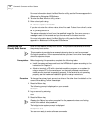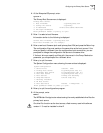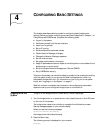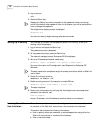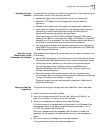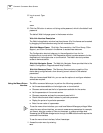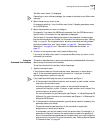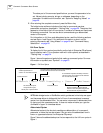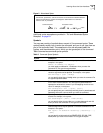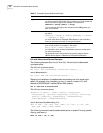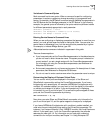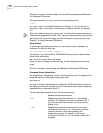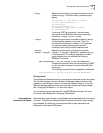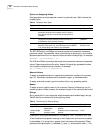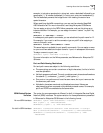
22 CHAPTER 4: CONFIGURING BASIC SETTINGS
The value part of the command specifies how you want the parameter to be
set. Values include numerics, strings, or addresses, depending on the
parameter. For additional information, see “Syntax for Assigning Values” on
page 28.
2 After entering the complete command, press the Return key.
The bridge/router software includes online help for commands, services,
parameters, and syntax, described in “Getting Help” on page 28. The syntax that
appears in online help is the full-form syntax; it contains full names and visual cues
for entering commands. You can also enter commands using an abbreviated
version of the syntax.
For information on full-form and abbreviated syntax, read the following sections
and see Figure 1 and Figure 2. For additional information on short cuts for
entering commands, see “Using Aliases” on page 26 and “Command History
Substitution” on page 26.
Full-Form Syntax
To display the full-form syntax (provided by online help in Enterprise OS software)
type a question mark (?) or a question mark with other options, as described in
“Getting Help” on page 34.
Figure 1 shows the parts and symbols that make up command syntax. For more
information on symbols, see “Symbols” on page 23.
Figure 1 Full-Form Syntax
NETBuilder bridge/router or PathBuilder switch guides and online help use upper-
and lowercase letters to distinguish the full form of commands and command
syntax from the abbreviated form. You can enter a command in abbreviated form
by typing only the uppercase portion. It does not matter whether you type the
command in upper- or lowercase letters.
Abbreviated Syntax
Abbreviated syntax is the shortest unambiguous abbreviation of a command,
parameter, or value that can be entered. You can enter the abbreviated form in
lower- or uppercase letters at the Enterprise OS prompt.
Figure 2 shows the abbreviated syntax that corresponds to the full-form syntax in
Figure 1.
SETDefault !<path> -FDDI InsertPolicy = [Insert | DoNotInsert]
A hyphen always precedes service name and must
be entered if the service name is entered.
Command name
An exclamation point
must precede a port,
virtual port, or path number.
Service name
Parameter name
Square brackets enclose optional
values or a list of optional arguments.
Do not enter the square brackets.
A vertical bar separates mutually exclusive
values in a list, one of which can be entered.
Do not enter the bar itself.
Angle brackets enclose
variable parameters or
values. Do not enter brackets.



